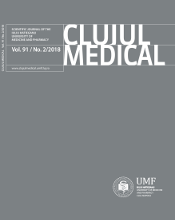Association of Midline Discrepancy with Tempromandibular Joint Disorder. A Systematic Review
DOI:
https://doi.org/10.15386/cjmed-832Keywords:
TMD, midline, asymmetry, systematic reviewAbstract
Aim. The aim is to evaluate the association between midline discrepancies and tempromandibular disorders (TMDs).
Methods. Literature search was performed by using various search engines to include human studies in English. TMDs include a wide variety of signs and symptoms such as pain in and around TMJ, jaw muscles, clicking and locking of jaws, pain during mandibular movement and restricted mandibular movements. The etiology is multifactorial, including one or several of the following factors like severe malocclusions (increased overjet, retroclination of incisors, cross bite, CR CO discrepancies etc), stress and psychological factors, structural abnormalities as possible etiology. There are controversies concerning the association between different traits of malocclusion and TMDs. The aim of the present study was to find out any association between signs and symptoms of TMDs with midline discrepancies, which represent an important trait of malocclusion.
Result. Of the seven studies evaluated in this systematic review for investigating the association between midline discrepancy and TMD, six had moderate grade (B) of evidence. Four studies of moderate grade evidence (B) showed a significant association between the presence of midline shift and TMDs, and the remaining studies (two) had non-significant association. Only one study had a strong grade of evidence (A) and interestingly it denies the presence of midline shift to be a causative factor for TMDs. So, it can be concluded that the results are inconclusive regarding the association of midline discrepancies with TMDs. Nonetheless, this requires concrete evidence which necessitates further long term research into this aspect.
Result – Of the seven studies evaluated in this systematic review for investigating the association between midline discrepancy and TMD, six had moderate grade (B) of evidence. Only one study had a strong grade of evidence (A) and interestingly denies the presence of midline shift to be a causative factor for TMDs. Moreover, four studies showed a significant association between the presence of midline shift and TMDs and remaining studies had non-significant association. So, it can be concluded that although not strong but some evidence is there regarding the association of midline discrepancies with TMDs. Nonetheless, this association requires concrete evidences which necessitate further long term research in this aspect.Downloads
Published
How to Cite
Issue
Section
License
The authors are required to transfer the copyright of the published paper to the journal. This is done by agreeing to sign the Copyright Assignment Form. Whenever the case, authors are also required to send permissions to reproduce material (such as illustrations) from the copyright holder.

The papers published in the journal are licensed under a Creative Commons Attribution-NonCommercial-NoDerivatives 4.0 International License.

